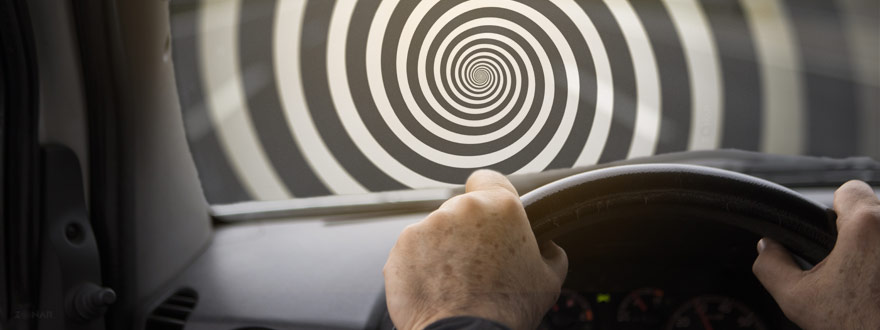Help your drivers fight highway hypnosis

How well do you remember the drive to work today? What about every mile of every road trip you’ve taken? Few people recall each drive with absolute clarity—because of highway hypnosis.
Most drivers know the risks of distracted driving and falling asleep behind the wheel. Highway hypnosis is just as dangerous. Also known as white line fever, highway hypnosis is a naturally occurring, trancelike state in which the brain’s processing and responses are dulled. Drivers in this state slip deep into thought about something else while driving without consciously thinking about it. Reaction times are slower. Cognitive processing is diverted. Hands are on the wheel, but the mind is elsewhere.
People are at higher risk for highway hypnosis when driving:
- familiar, mundane, everyday routes
- long, monotonous roads with few turns or signals
- for an extended period of time
- while tired, drowsy or fatigued
All of which happen every day on commercial routes, raising the risk of accidents and crashes. Any accident is bad enough, but those involving commercial motor vehicles (CMVs) are more complicated due to the legalities and financial consequences involved. (To learn more, download our free white paper, The Real ROI for Real-time Driver Coaching.)
Regardless of how experienced drivers are, when the mind wanders, so can the vehicle.
Lane drifting
“Crashes resulting from lane departures can be among the deadliest collisions,” according to the U.S. Department of Transportation. And, in 2015, “nearly 13,000 people died in single-vehicle run-off-road, head-on, and sideswipe crashes where a passenger vehicle left the lane unintentionally.”
While that source doesn’t focus on commercial motor vehicles specifically, it does highlight the dangers of wandering outside the lane. Lane drifting in a 4,000-pound passenger car is dangerous enough. Doing so in an 80,000-pound semi-trailer truck is another matter.
Speeding
CMV drivers under the influence of highway hypnosis aren’t necessarily paying attention to how fast they’re driving. Numbers don’t lie; speeding CMVs are prevalent.
- More than 131,000 drivers were cited for speeding in 2018. (per the FMCSA)
- Speeding accounts for 13% of all large truck violations. (per the FMCSA)
- 9,717 people were killed in speeding-related crashes in 2017 (per the NHTSA)
- Speed “was a factor in 17% of truck crashes with at least one large truck occupant fatality.” (per the FMCSA)
Speeding kills, but it’s preventable. (Read our article Save Lives. Teach Your Drivers to Slow Down. to learn more.)
Velocitation and highway hypnosis go hand in hand.
Highway hypnosis makes being alert to velocitation more difficult.
Drivers often sustain high rates of speed on interstates and highways, especially at night or during long stretches outside city limits. As long as they’re obeying posted speed laws, that’s fine. But when drivers exit, they don’t realize how fast they’re going. They’ve become visually accustomed to objects such as trees and buildings passing by at a certain rate. Having spent so long traveling at a high speed, drivers’ ability to judge velocity is temporarily altered—which makes exiting too fast all too easy.
Following too close
Large trucks and buses take longer to stop than passenger cars. A fully loaded semi-truck traveling at 65 mph in good conditions needs approximately two football fields of stopping distance.
Vehicles need even more distance when they’re:
- speeding
- carrying heavy loads
- traveling in inclement weather
- traveling on dangerous roads
- being driven by an inattentive driver
Stopping distance only includes the time required to stop—not the time required to notice the need to stop. And one vehicle can follow another too closely for speed and conditions without technically tailgating. Drivers under the influence of highway hypnosis need more time to notice the situation before applying the brakes—and therefore more stopping distance.
Keeping drivers alert with today’s technology
All drivers, professional and otherwise, are susceptible to highway hypnosis. Chances are your commercial drivers fall under its influence on occasion. Doesn’t mean they’re bad drivers; just that they could use some help staying alert. Start by using today’s technology to extend your proactive safety efforts and keep drivers operating as safely as possible.
Alert drivers in real-time.
Put a coach in the cab with each driver. Preferably, one that immediately alerts them to unsafe behavior then and there. Look for a driver coaching solution that features a smart dashcam with artificial intelligence and machine learning. This solution should scan the road and automatically detect unsafe behavior.
Look for a solution that detects:
- lane drifting
- speeding
- following too closely
-plus-
- rolling stops
- hard braking
- hard acceleration
- hard cornering
When this coaching solution detects specific unsafe events, it needs to provide immediate, in-cab, audible alerts for drivers to correct their behavior before it’s too late—even if they’re on ‘auto pilot.’
Prevent catastrophic vehicle failure.
Handling a multi-ton vehicle during a major breakdown takes sharp reflexes. Drivers under the influence of highway hypnosis are slower to respond, which can make the difference between safely pulling off to the side or causing a fatal accident.
In 2018, according to the FMCSA, more than 3,500,000 roadside inspections were conducted, and 20.82% of the vehicle inspected were placed out of service. Proper vehicles inspections won’t keep drivers alert, but ensuring the vehicle is in safe operating condition reduces the likelihood of a sudden, dangerous breakdown.
Ensure alert systems work properly.
Something as simple as running low on fuel can be easily ignored when the driver isn’t paying attention. Check engine lights, low oil level lights, general alerts and so on—every indicator light needs to work.
If the driver doesn’t realize the vehicle needs attention, that vehicle can end up on the side of the road or worse, as an obstacle in traffic. Both scenarios are unsafe, unproductive and easily preventable by making sure dashboard indicators and alert systems function properly before each trip.
Dashboard alerts that function properly give the highway hypnotized driver a chance to ‘wake up’ when the light goes on.
Ensure drivers get required rest hours.
Highway hypnosis is a precursor to falling asleep at the wheel. Keeping drivers rested keeps them alert. The Federal Motor Carrier Safety Administration (FMCSA) ELD mandate requires drivers to track their hours of service (HoS) and take required breaks. HoS regulations are a safety measure to keep drivers from driving while fatigued, and a quality ELD solution ensures accurate tracking.
Right provider, right technology
Work with a provider that offers a full suite of smart fleet management technology so you can approach fleet safety from every possible angle. Our in-cab driver coaching and patented electronically verified inspection solutions were designed with safety in mind, and keep drivers stay alert and fleet vehicles running safely. Equip vehicles with audible, in-cab alerts. Monitor driver behavior. And set back-office managers and dispatchers up as secondary support systems to keep tabs on unsafe behaviors on the road.
About Zonar
Founded in 2001, Zonar has pioneered smart fleet management solutions throughout trucking and vocational industries. Zonar helps fleets of all sizes maximize the use of their assets with technology solutions dedicated to improving compliance, efficiency, maintenance, safety, and tracking. Cloud-based services with open APIs drive Zonar’s smart fleet solutions by making it easy for fleet owners and managers to stay connected to their fleets and operators to dispatch. Headquartered in Seattle and part of the Continental AG family—a global leader in automotive technology— Zonar also has a Technology Development Center in downtown Seattle, a regional office in Cincinnati and a distribution center outside of Atlanta.





